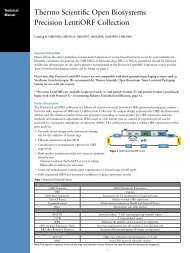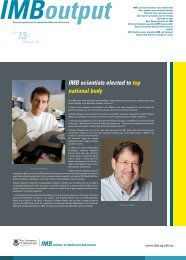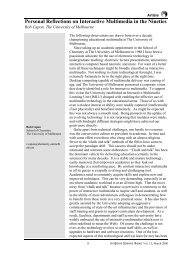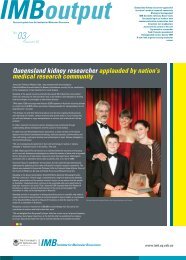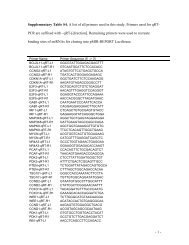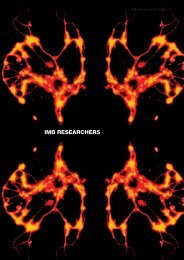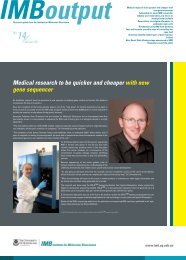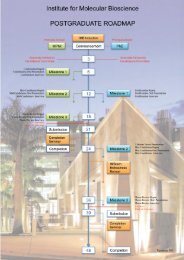2010 Annual Report - Institute for Molecular Bioscience - University ...
2010 Annual Report - Institute for Molecular Bioscience - University ...
2010 Annual Report - Institute for Molecular Bioscience - University ...
Create successful ePaper yourself
Turn your PDF publications into a flip-book with our unique Google optimized e-Paper software.
81 community engagement<br />
COMMUNITY ENGAGEMENT<br />
MUCH OF THE COMMUNITY<br />
engagement that took place in <strong>2010</strong><br />
was based around UQ’s Centenary<br />
year. IMB decided to mark the occasion<br />
by resurrecting the Ångström Art<br />
competition. Originally held in 2001,<br />
Ångström Art was the result of an<br />
Australia-wide imaging competition<br />
run by the IMB. Several collections<br />
of images were produced be<strong>for</strong>e the<br />
competition went on hiatus.<br />
In <strong>2010</strong>, we decided to restrict the<br />
competition to IMB researchers only,<br />
trans<strong>for</strong>ming Ångström Art into<br />
a visual showcase of the <strong>Institute</strong>’s<br />
research. Researchers from all divisions<br />
of the IMB were inspired by the<br />
competition, with 62 images entered<br />
RUNNER UP: ÅNGSTRÖM ART CENTENARY COLLECTION<br />
in total. A judging panel consisting of<br />
Professor Stephen Walker, Dean of UQ’s<br />
Faculty of Science; Mrs Beverley Trivett,<br />
Director of the John Trivett Foundation,<br />
which supported earlier Angstrom Art<br />
competitions; and Mr Nick Mitzkevich,<br />
Director of the UQ Art Gallery; selected<br />
one winner and two runners-up.<br />
Mr Darren Brown from the Stow<br />
group contributed the winning image,<br />
MacBeads (seen on the front of<br />
this report) and runner-up image<br />
RealMacAlien. Dr Michael Landsberg<br />
from the Hankamer group was the other<br />
runner-up <strong>for</strong> his image, Insect Assassin.<br />
All 62 images can be viewed on the<br />
Angstrom Art website at www.angstromart.com.<br />
These images were displayed<br />
at an internal IMB exhibition, and at<br />
external exhibitions at UQ’s Celebration<br />
of Centenary on Sunday April 18, and at<br />
UQ’s Open Day on August 1.<br />
IMB’s Marketing team also produced<br />
iPhone skins and postcards with the<br />
Angstrom Art images, which have<br />
proven immensely popular at both<br />
community and scientific events. If you<br />
would like some postcards or an iPhone<br />
skin, please contact imb@imb.uq.edu.au<br />
THE IMB WEBSITE (www.imb.uq.edu.<br />
au) continues to be the main portal of<br />
in<strong>for</strong>mation about the institute, including<br />
its newsletter Output (to subscribe,<br />
please click on the green ‘Subscribe’<br />
button on the IMB homepage). The<br />
IMB News section of the website nearly<br />
tripled the number of hits it received in<br />
<strong>2010</strong> compared to 2009, with around<br />
125,000 in 2009 and nearly 350,000<br />
in <strong>2010</strong>. The website remains in the<br />
number one position when ‘molecular<br />
bioscience’ is searched in Google.<br />
MICHAEL LANDSBERG: INSECT ASSASSIN<br />
A number of techniques exist <strong>for</strong> studying<br />
the structure of proteins – the “worker<br />
molecules” of the cell. This image draws<br />
inspiration from the technique of single<br />
particle analysis, highlighting how it is<br />
now possible with current technology to<br />
reconstruct in three-dimensions, images<br />
of individual macromolecular protein<br />
complexes.<br />
The “walls” of the room illustrate various<br />
steps in the process of single particle<br />
analysis – the visualisation of individual<br />
protein complexes, computational<br />
image averaging and three-dimensional<br />
reconstruction – to obtain a final threedimensional<br />
structure.<br />
The structure shown floating in the centre<br />
of the room is around 30 nanometres<br />
in length (around one millionth of a<br />
centimetre) and was determined by<br />
combining over 10 000 images captured<br />
by electron microscopy. It is being<br />
investigated because of its insecticidal<br />
properties.<br />
THE IMB SCIENCE AMBASSADOR<br />
program continued to be a success.<br />
We had some turnover of ambassadors<br />
from our first cohort, ending up with<br />
18 ambassadors in total, including a<br />
mid-year intake. In its pilot year, the<br />
ambassador program was run by<br />
a committee consisting of two staff<br />
members and an ambassador. In <strong>2010</strong>,<br />
the committee decided to expand, and<br />
allow more ambassadors a chance<br />
to assist in guiding the program. The<br />
<strong>2010</strong> committee was: Phillippa Smith<br />
(Craik group) – Co-ordinator; Dr Richa<br />
Dave (Wainwright group) – Worksheet<br />
Manager; Dr Denis Bauer (Bailey group)<br />
– Vodcast Manager; Maggie Hardy<br />
(King group) – Committee Adviser; Dr<br />
Amanda Carozzi – Postgraduate Student<br />
Co-ordinator; and Bronwyn Adams –<br />
Marketing and Communications Officer.<br />
Each of these committee members did<br />
an excellent job in ensuring the success<br />
of the program beyond its pilot year.




